Furniture
Introduction
Text-to-speech Audio
Mrs. Howard’s uniquely carved furniture fills the hallways and rooms in the philanthropic center. On the Chinese cabinets and chairs, look for flowers, phoenixes, dragons, and even monkeys. On the American cupboards, look for Shakespeare, Beethoven, Columbus, and Da Vinci...
In addition to the furniture from Mrs. Howard, over the years members and friends have donated other pieces which are listed as the Asian Art Collection...
Most pieces in the Breslauer Chapter Room were made during the late Qing dynasty (mid-to-late 19th century) and are fine examples of Chinese carving. Because of deforestation, even as early as the Ming dynasty (1300-1600), China had to import the best woods from other countries. Some of our pieces are made from one of the most popular woods, Burmese or East Indian rosewood, also known as padouk wood. Most of the Howard pieces are carved from one of the forms of this prestigious wood. Another wood that was preferred even to the highest grade of padouk is called tzu-t’an which translates to purple sandalwood or blackwood. The blackwood is so dark that it is purplish in color and is the most dense and heavy of Chinese hardwoods, very much like western mahogany...
If furniture had ears, the three one-of-a-kind American pieces would have interesting stories to tell. Originally built in the 1860s for Charles Godfrey Gunther, the Mayor of New York City from 1864-1866, they were purchased by Alfred Dolge in 1895 for his new mansion in upstate New York. He brought them all to California after his financial catastrophe and forced bankruptcy in Dolgeville. The Howards bought the pieces from his estate in 1922...
Just as Mrs. Howard and the other owners used this furniture in their homes for practical purposes as well as aesthetic enrichment, we can appreciate the elegance and artistry of each piece today...
The best way to learn about the furniture is to walk around and look at it closely as you read or listen to the information in the Backstory section...
Click on the first photo to enjoy the slide show.
Images
Jewelry Cabinet with 18 drawers and ornately carved dragons on the front and top and phoenixes on the sides.
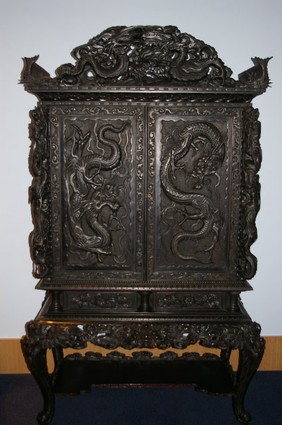
Phoenix on each side of the jewelry cabinet
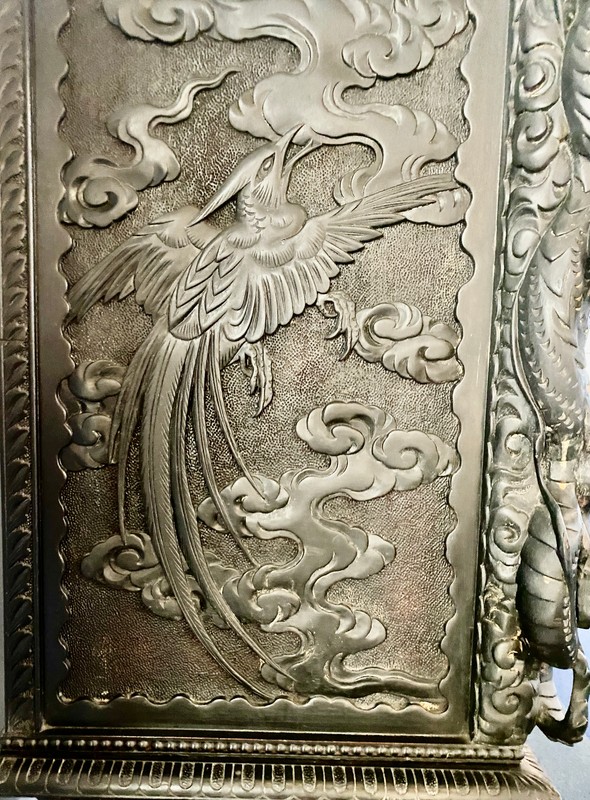
Dragon on the front of the Jewelry Cabinet
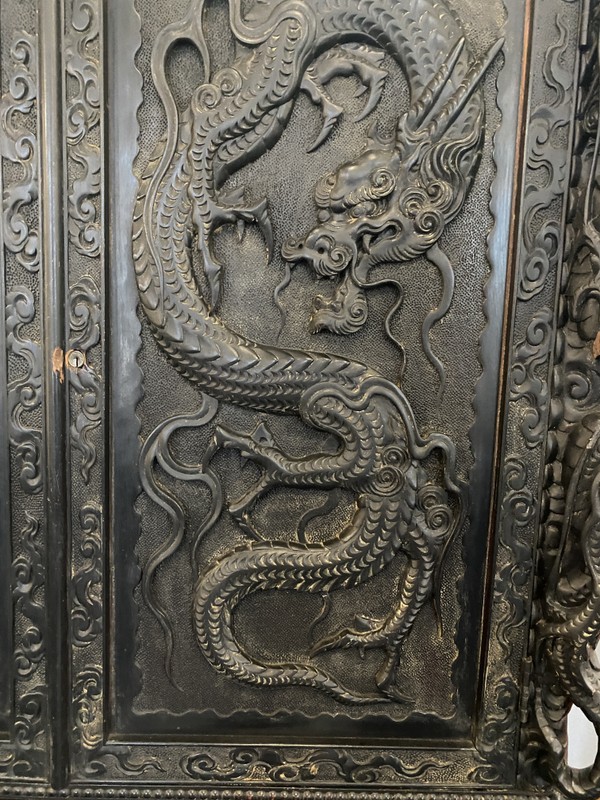
Griffin on the cabriolet leg
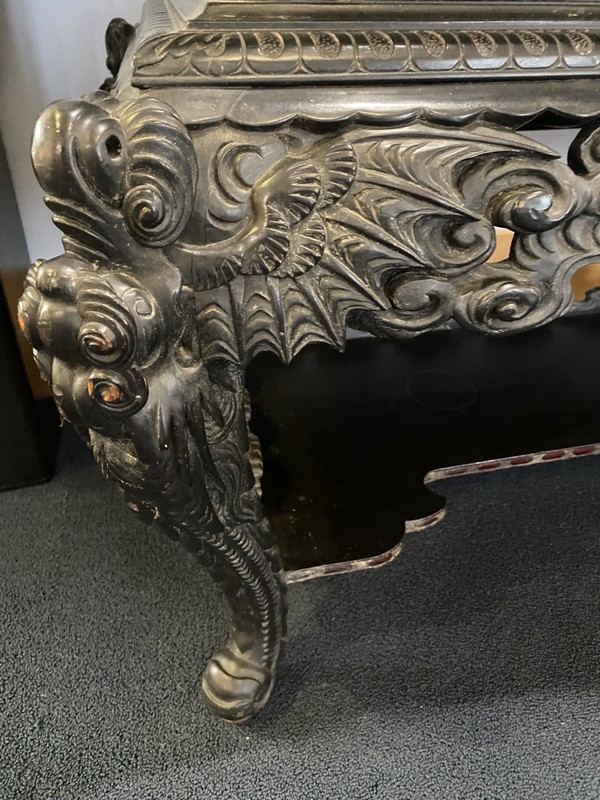
Dinner at the Howard's home at the magnificent table for 12
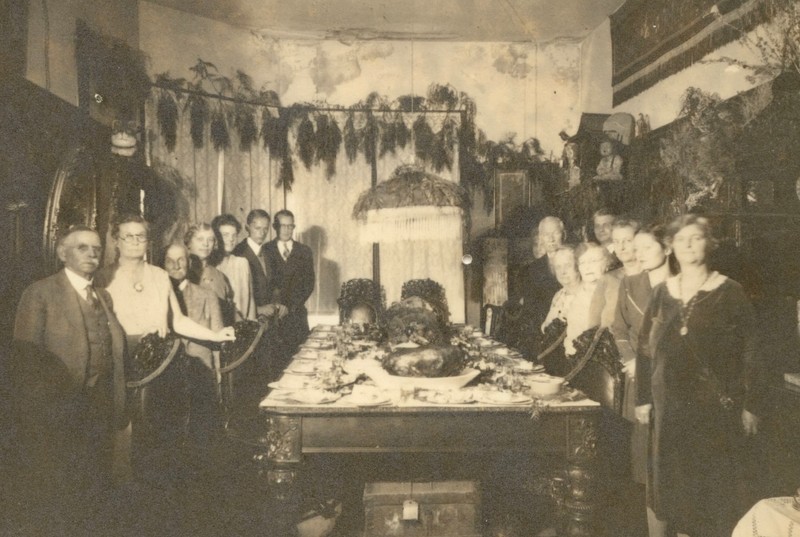
Eleven foot long blackwood dining table with carved legs and sides
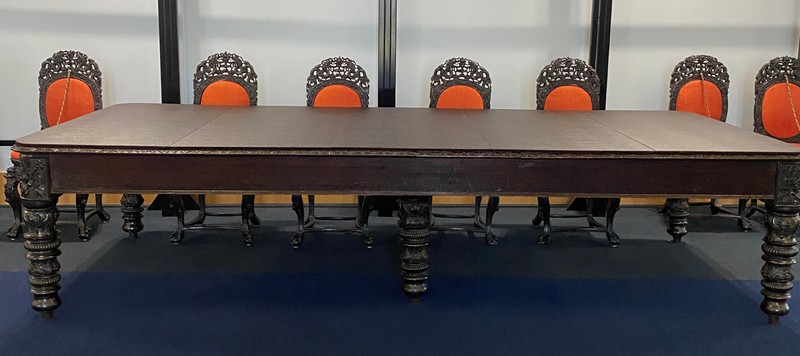
One of ten side chairs
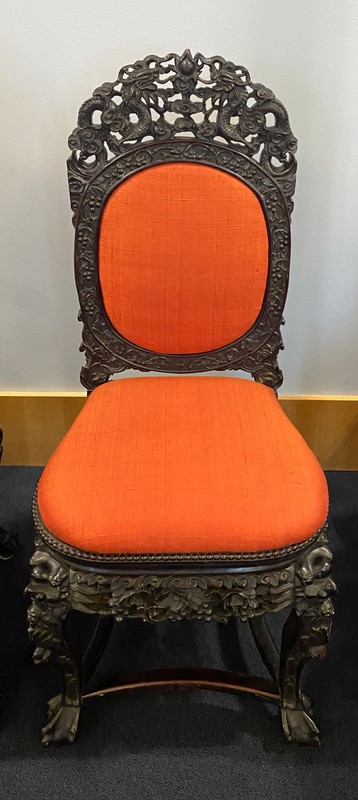
One of two arm chairs
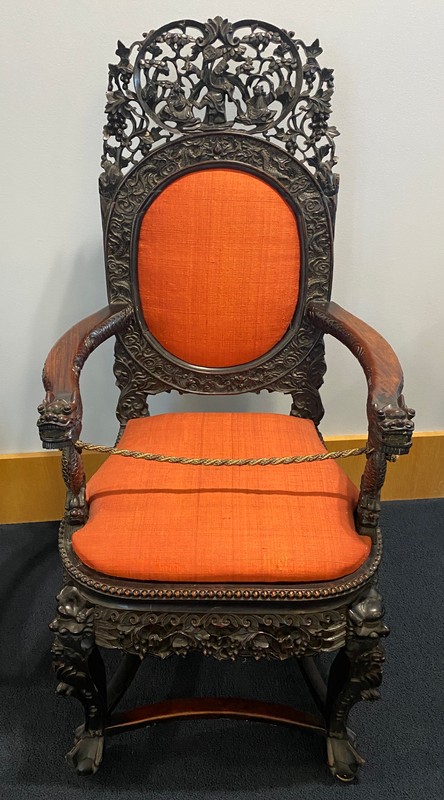
China Cupboard with Canton Famille Rose porcelain china set
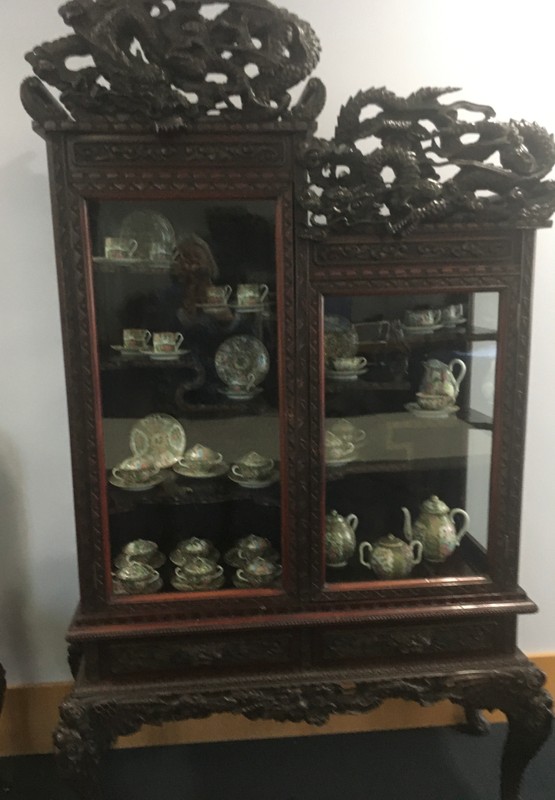
Writhing dragons on top of the china cupboard
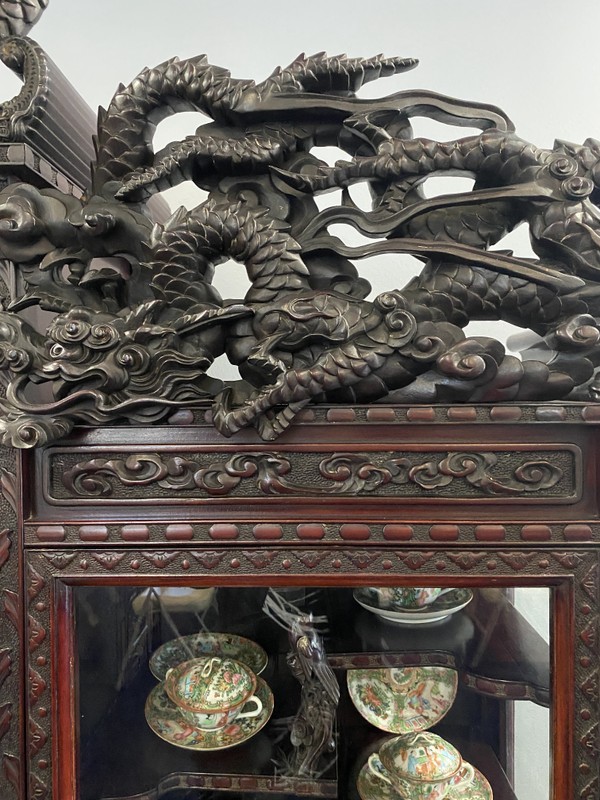
This Ancestor Scroll is unique because it shows five generations of family members.
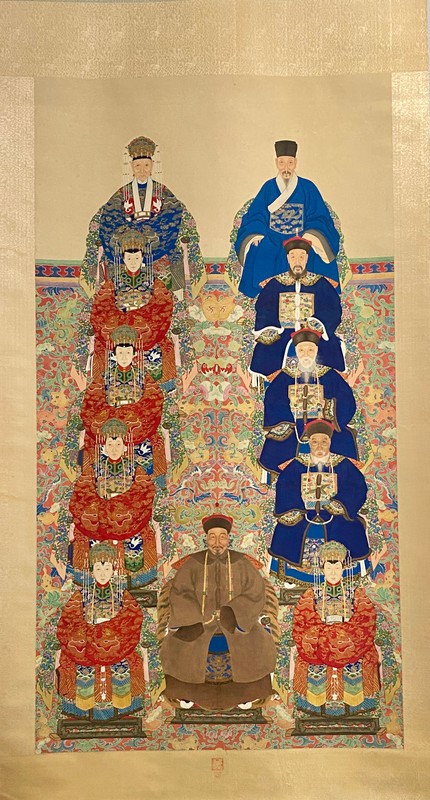
This young woman sits to the right of the man. Is she the daughter or wife?
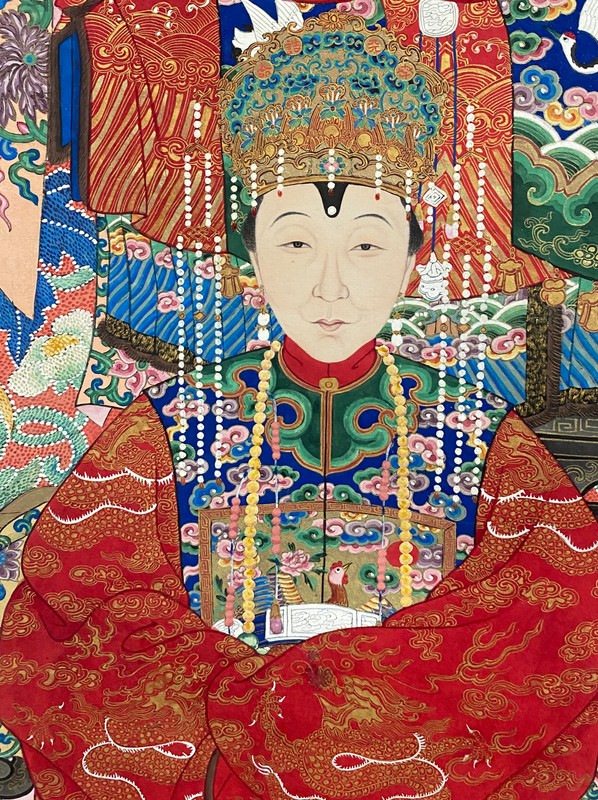
The current head of the family shows reverence for his ancestors.
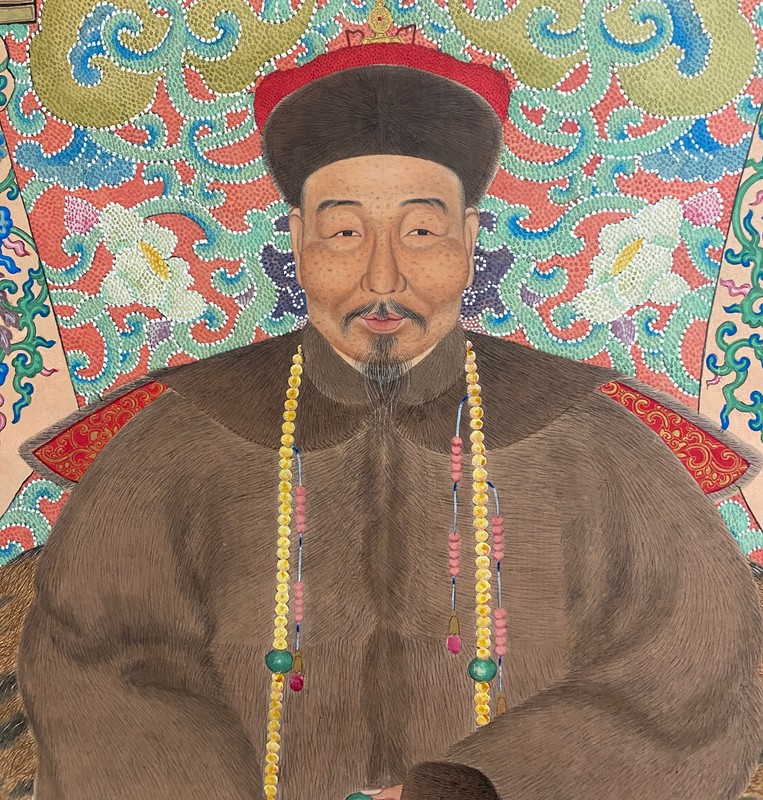
This woman of the family sits to the left of the man. Is she the wife or mother?
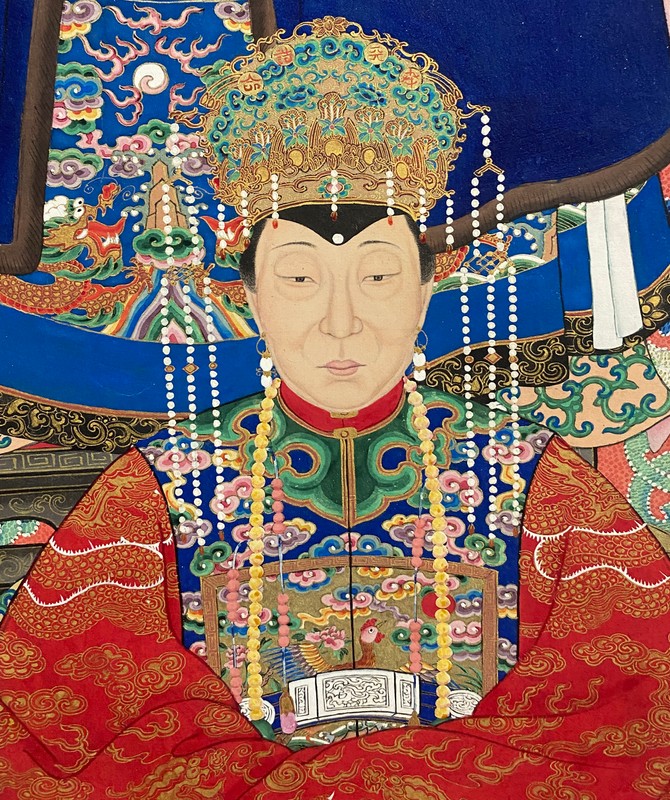
A hunter standing on the left side of the hearth
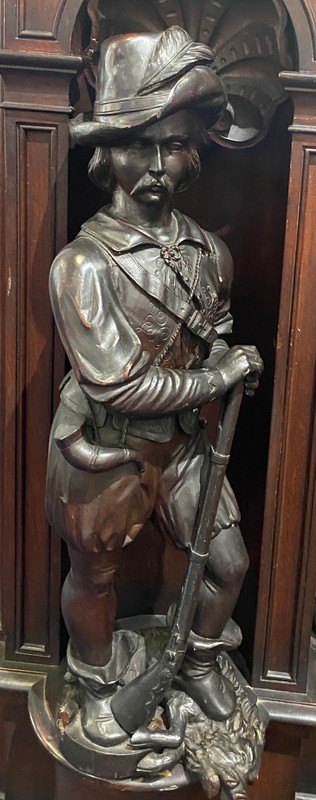
Fireplace with mantel and mirrored top
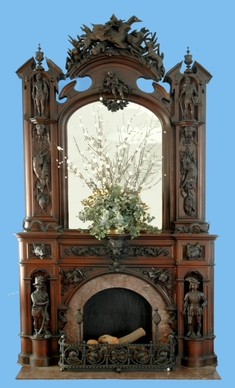
Carved wood fisherman standing on the right side of the hearth
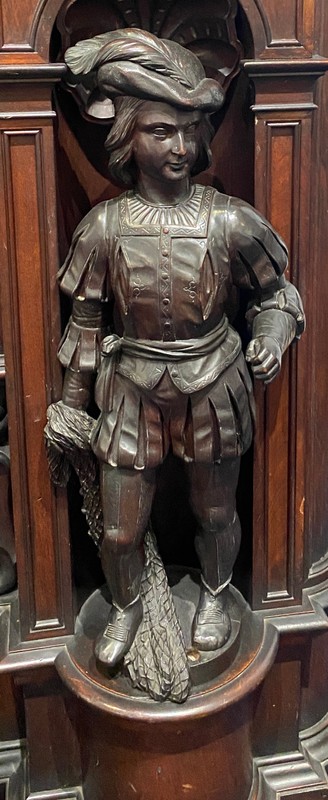
On the top of the fireplace, two Native American hunters proudly display their catch.
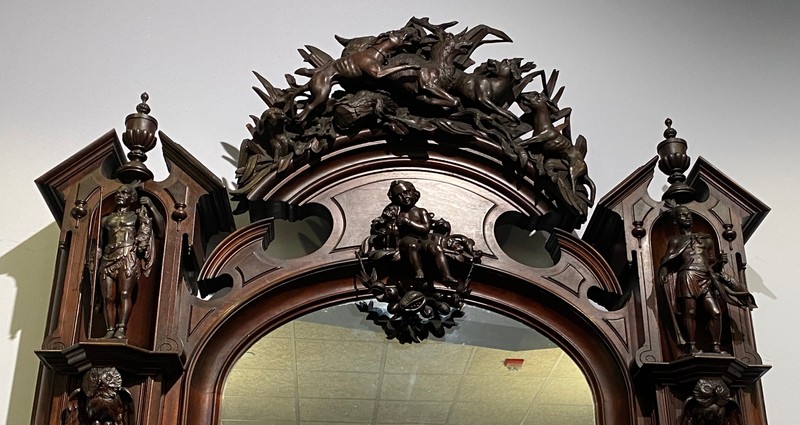
"Monkey Chair. " Monkeys symbolize mischief and trickery as these fellows climb up to steal peaches (symbols of immortality).
.jpg)
One of several monkeys stealing peaches
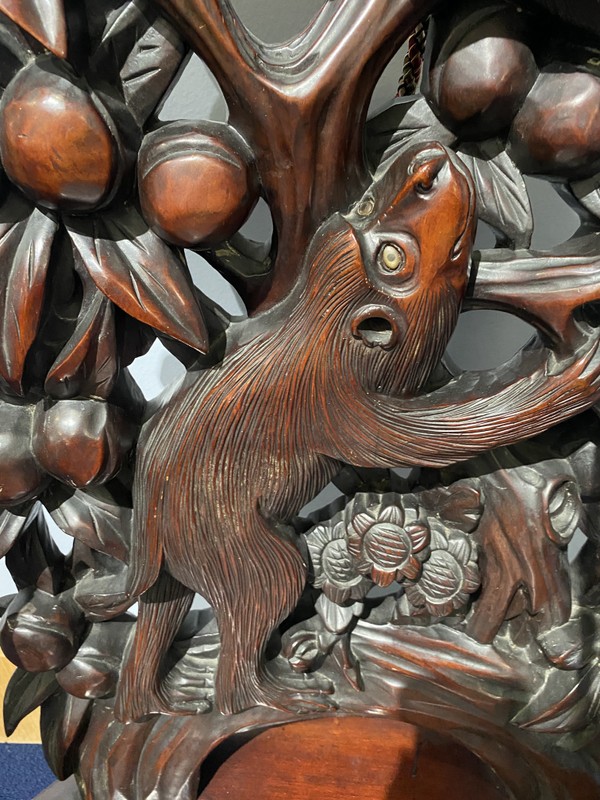
Dragon arm with ivory eyes on the monkey chair
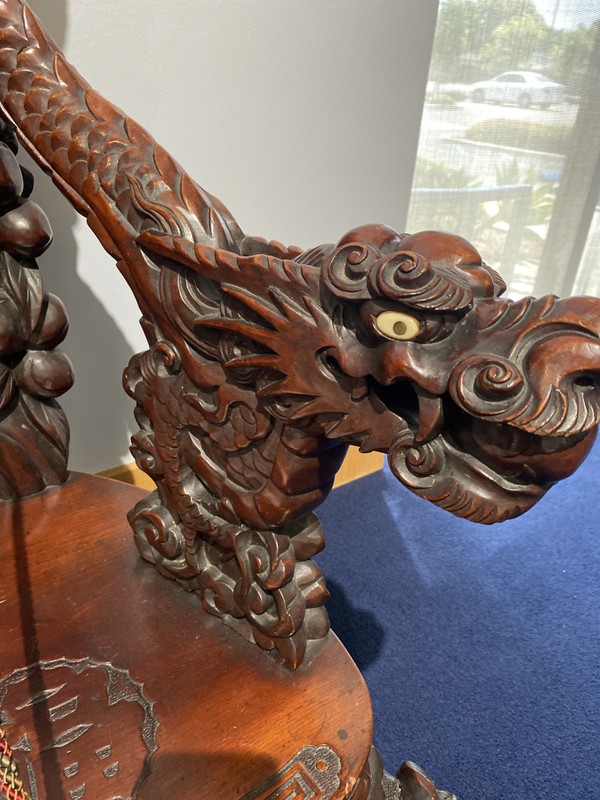
Chinese Coromandel screen with embossed ivory and mother of pearl birds and flowers
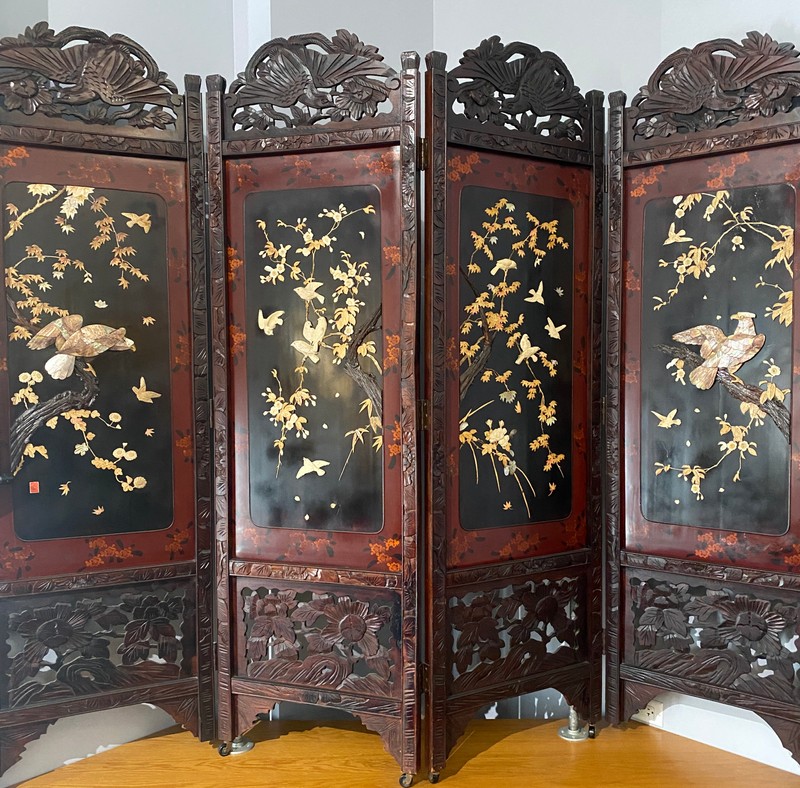
One of the birds from the Coromandel screen.
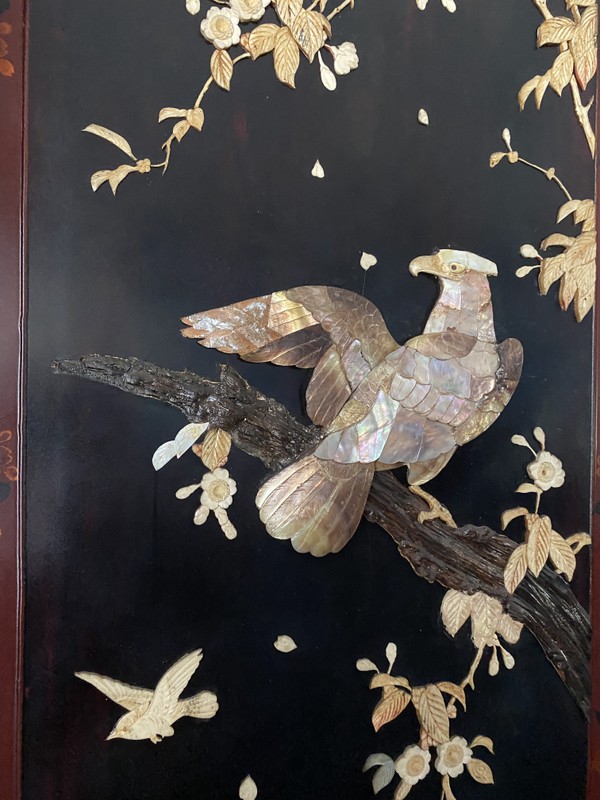
Detail of ivory and mother-of-pearl bird on the coromandel screen
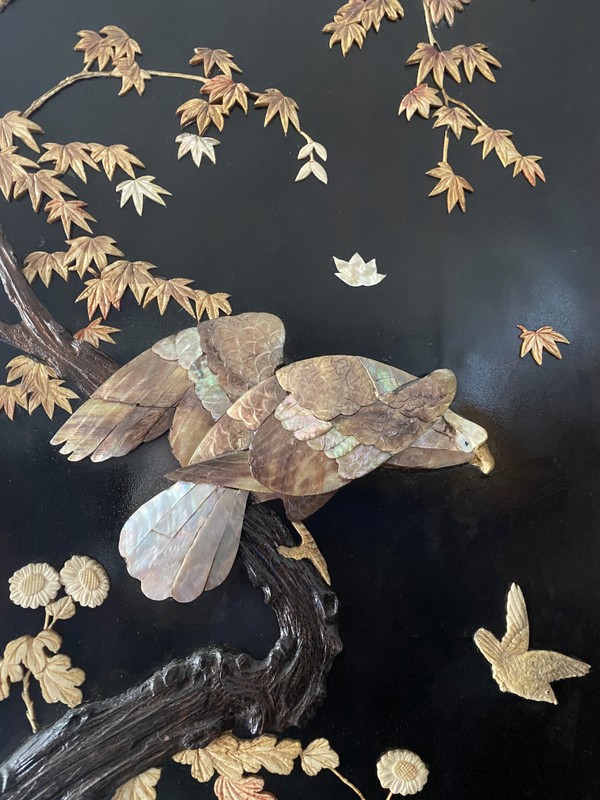
Blackwood buffet with elaborate openwork carving
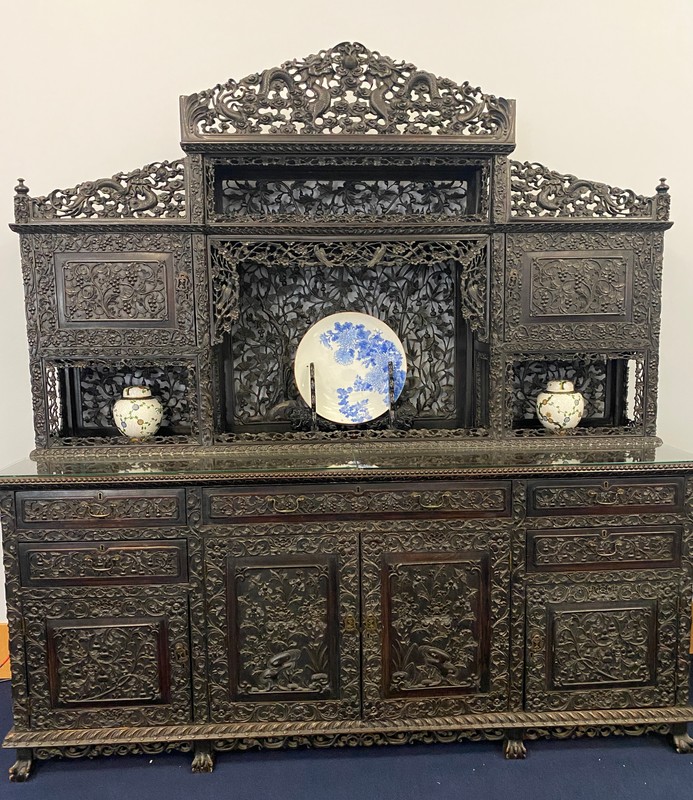
William Shakespeare--notice that the tools of a writer are carved along this upper side of the cabinet.
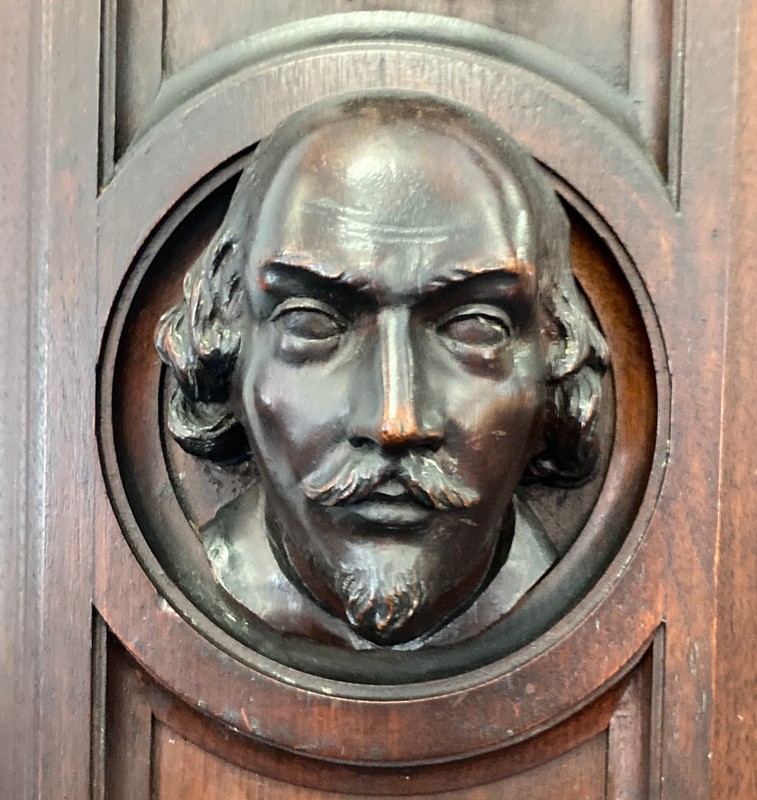
Cabinet carved for the Mayor of New York
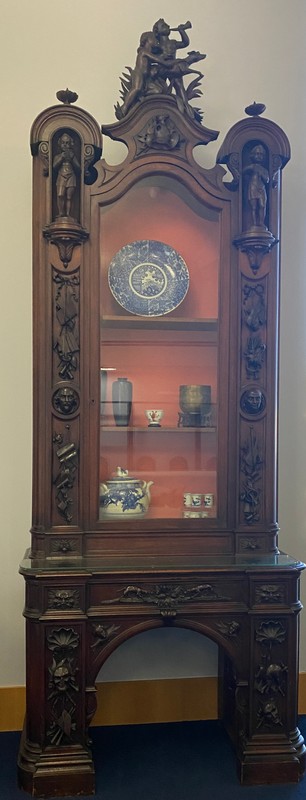
Beethoven--notice the artifacts of a composer along this upper side of the cabinet.
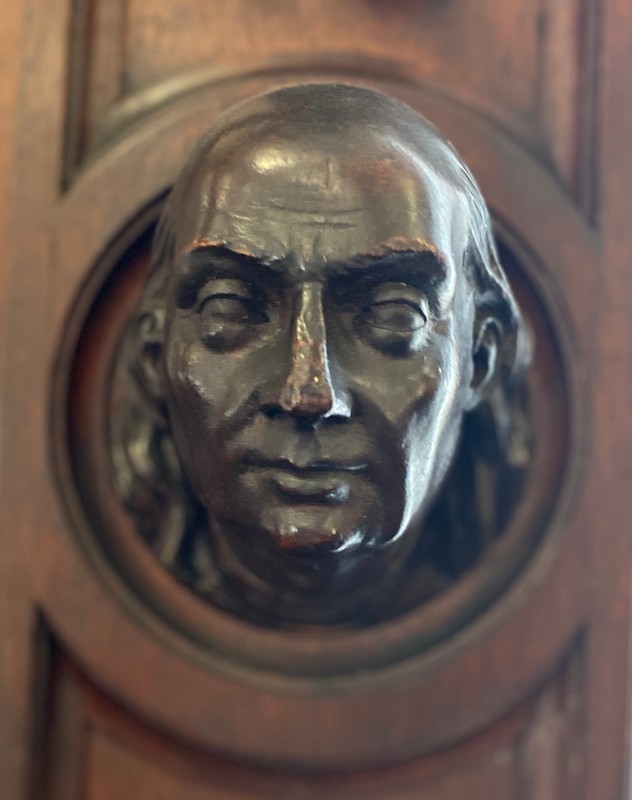
Secrets hide behind these doors
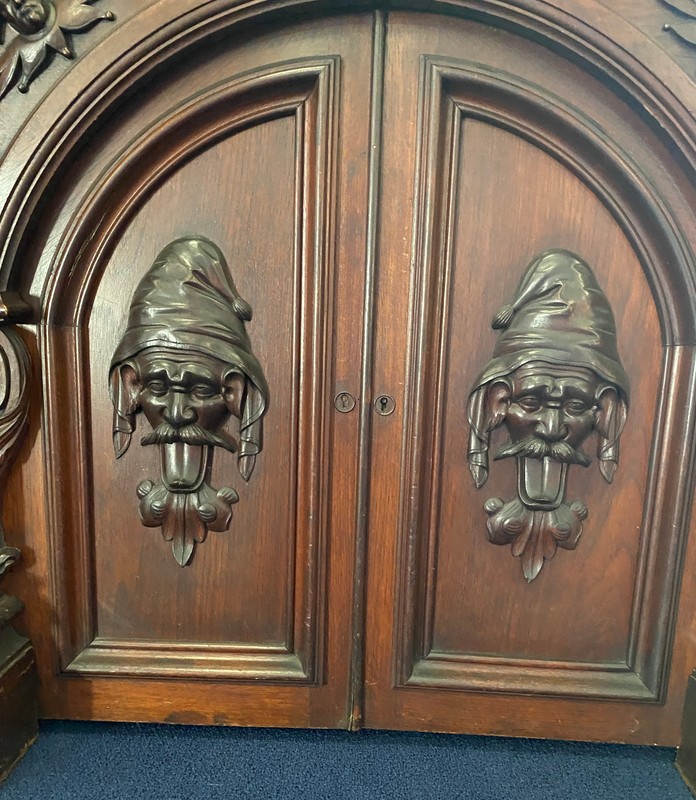
A secret latch opens each side door
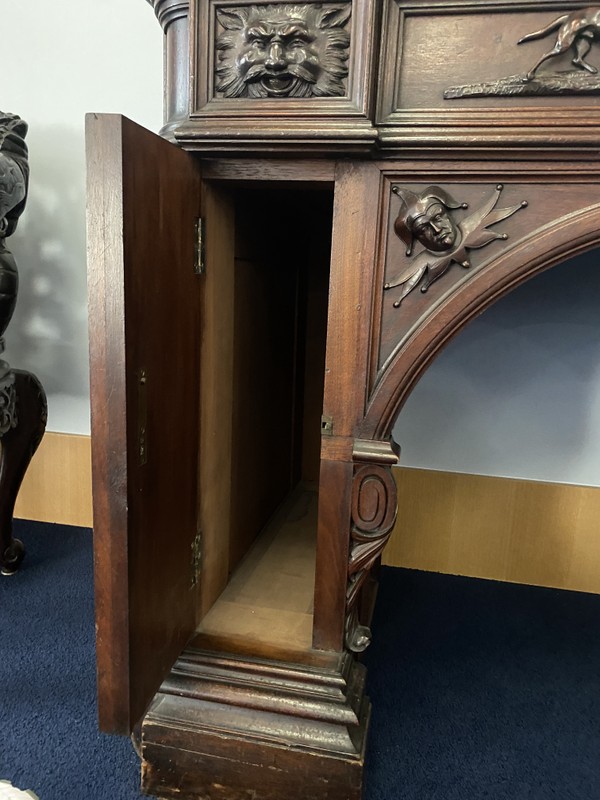
Christopher Columbus--notice that the tools of an explorer are carved along the upper side of the cabinet.
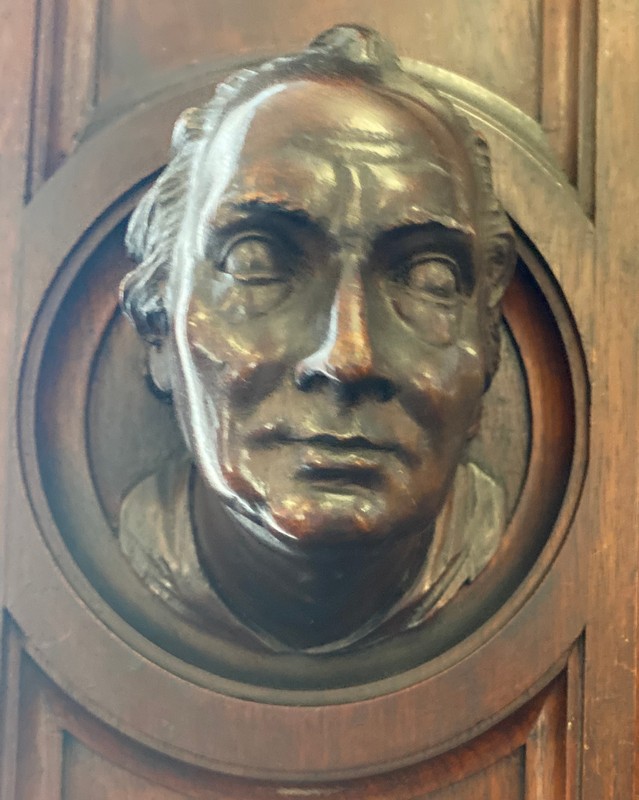
Second cabinet carved for the Mayor of New York
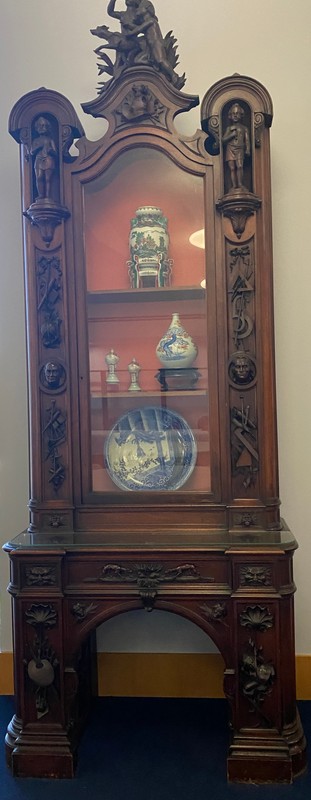
Leonardo DaVinci--notice that artist's tools are carved along the upper side of the cabinet.
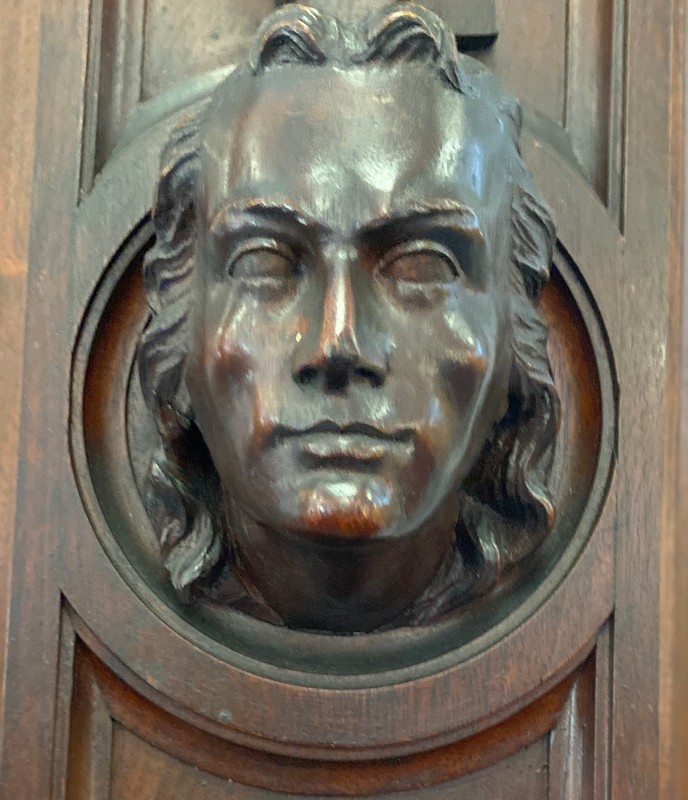
One of four Dragon Chairs. The armrests are dragon heads with pearls in their mouths.
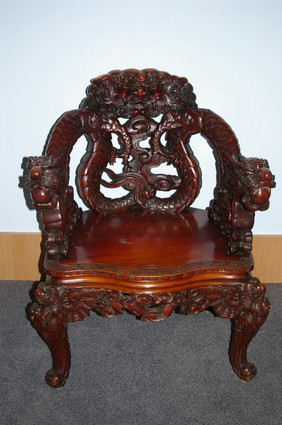
Observe the ornate carving of dragons on the back of this chair.
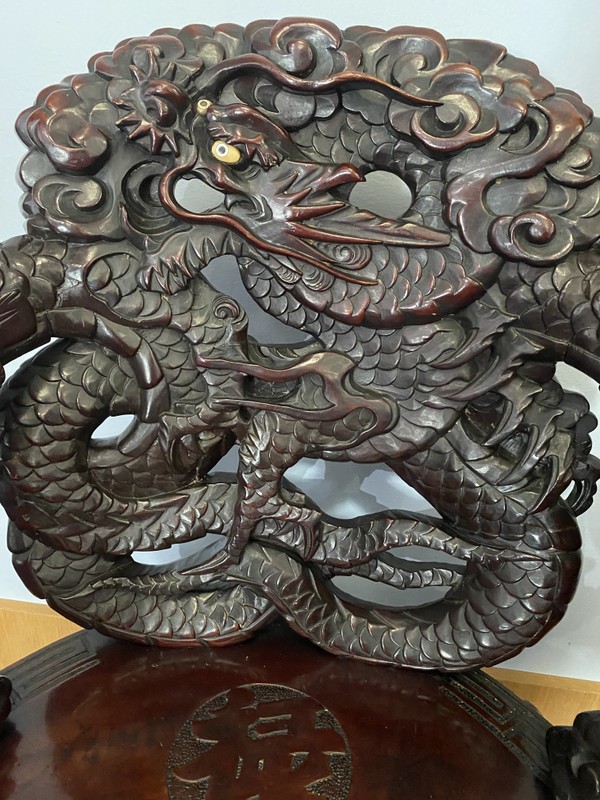
This seat of this dragon chair says, "wishes for good fortune, prosperity, and longevity."
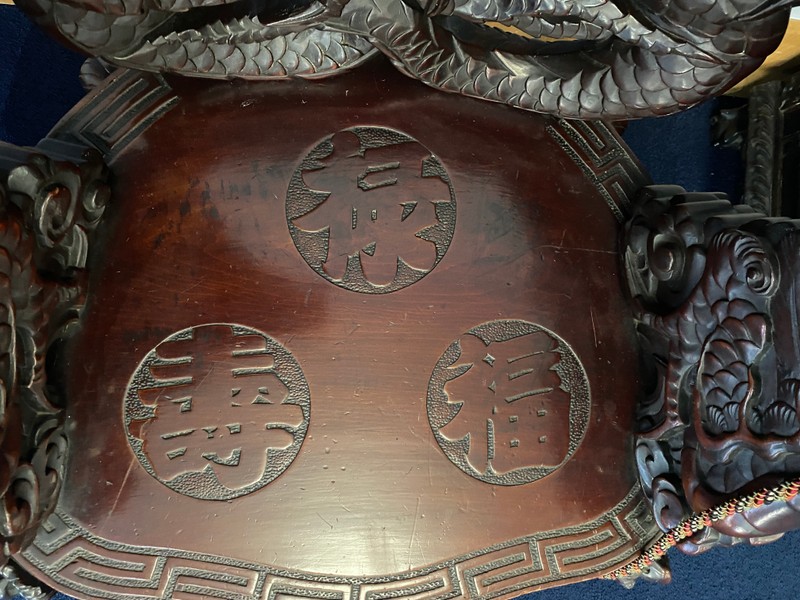
36" square rosewood table with dragons carved on the top and grapevines along the sides and legs.
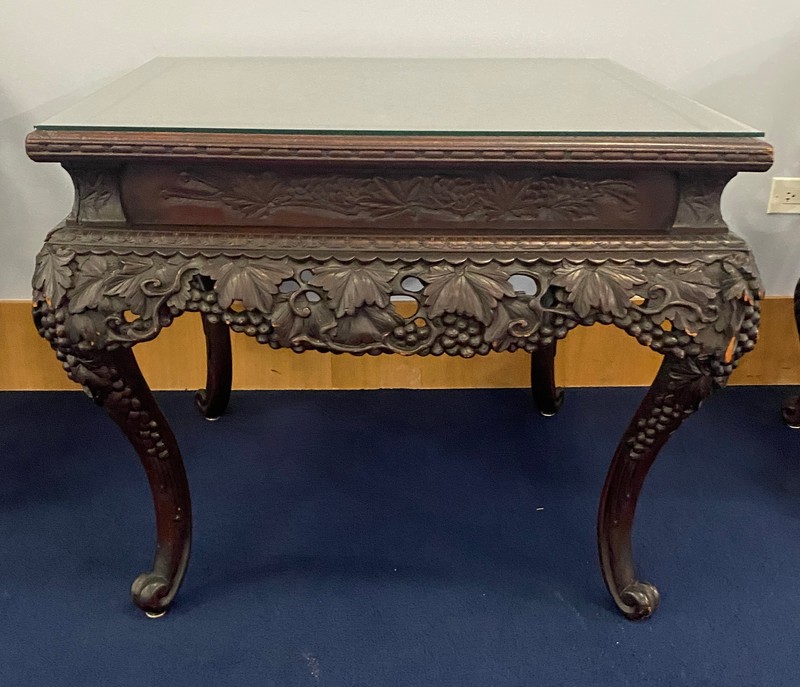
The sides and legs of the blackwood gaming table in the foyer is carved with chrysanthemums and other flowers.
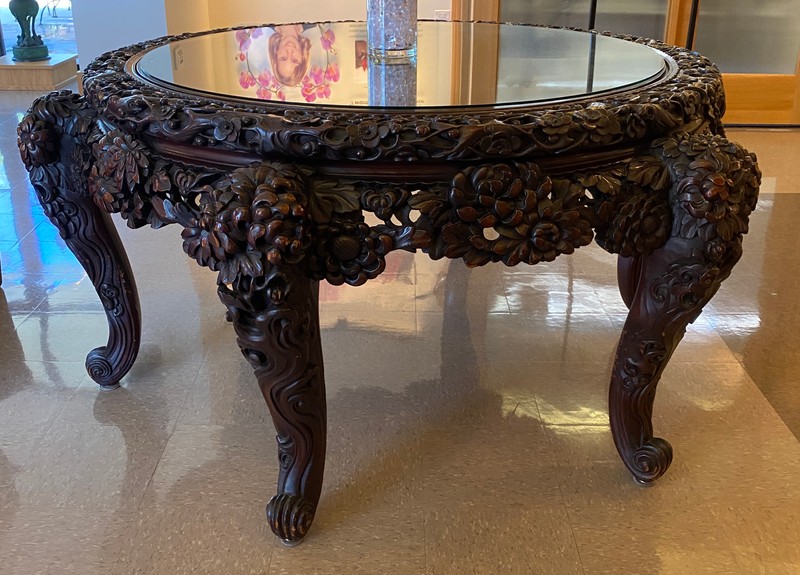
One of a pair of Chinese blackwood chairs in the foyer alcove.
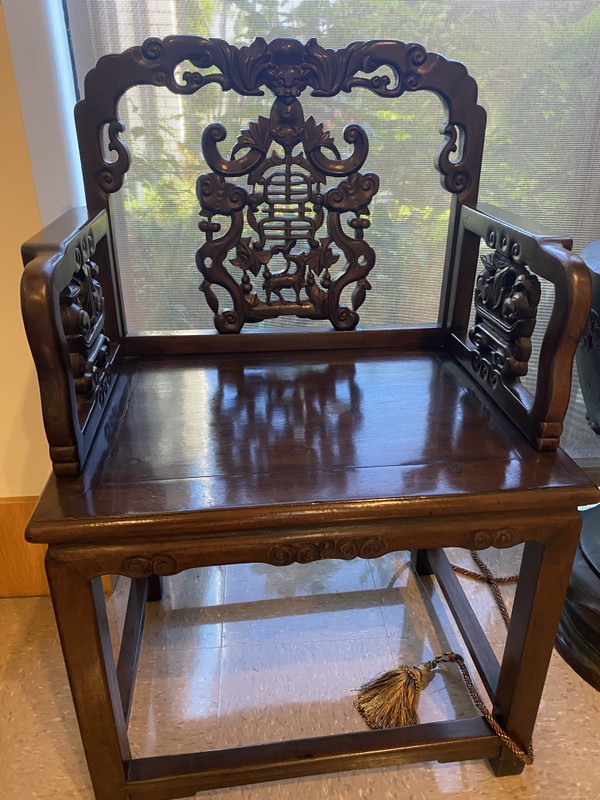
Japanese Temple Urn--observe the detailed images of the phoenixes and other birds.
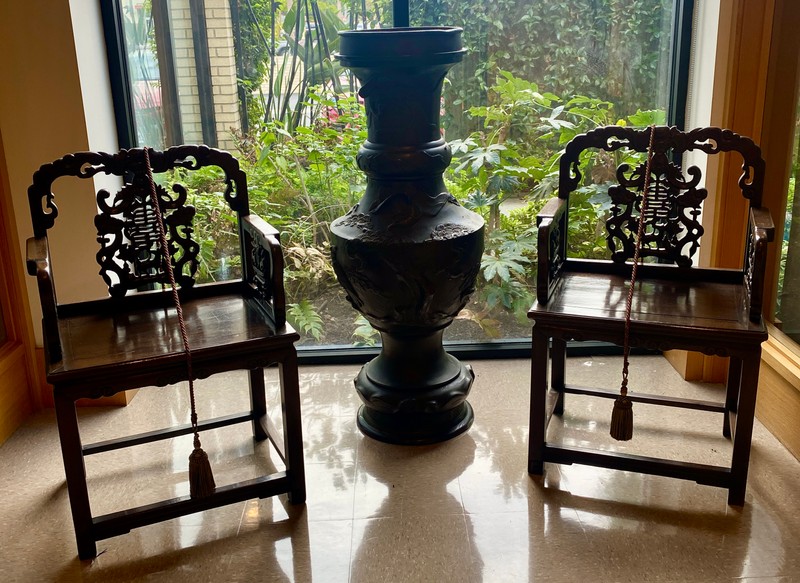
Notice the phoenix on the Japanese temple vase.
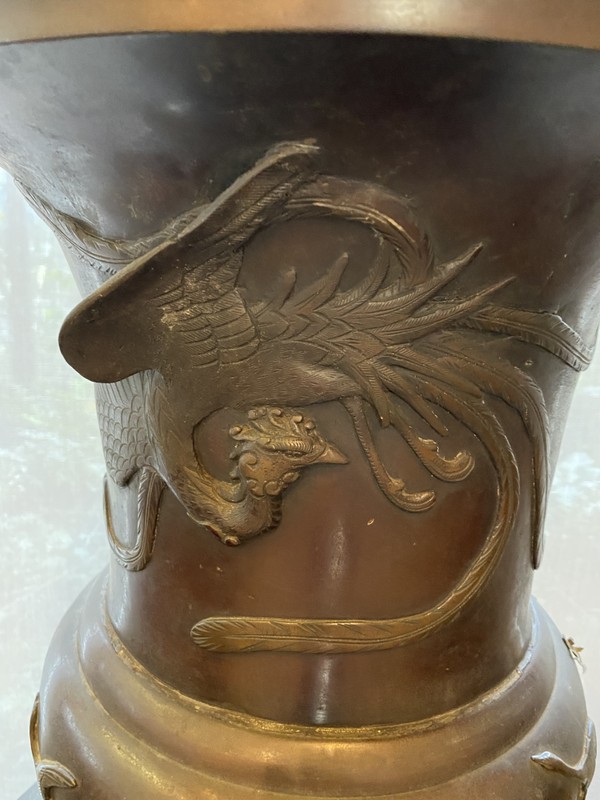
Observe the detailed images of birds on the temple vase.
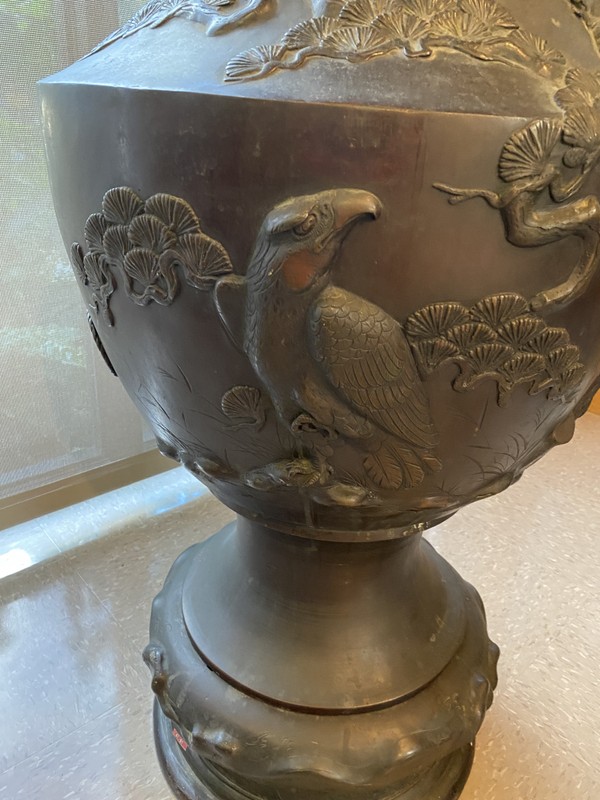
Three shelves and two drawers with openwork sculpture of bamboo stalks and leaves.
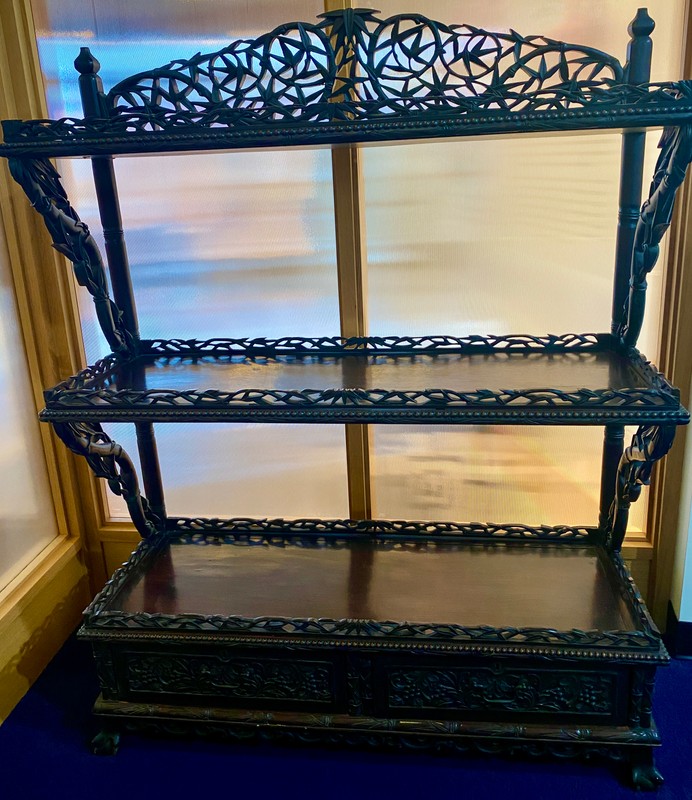
Ornately carved from the wood of one tree, this lacquered Chinese gumwood desk and chair are in the Board Room.
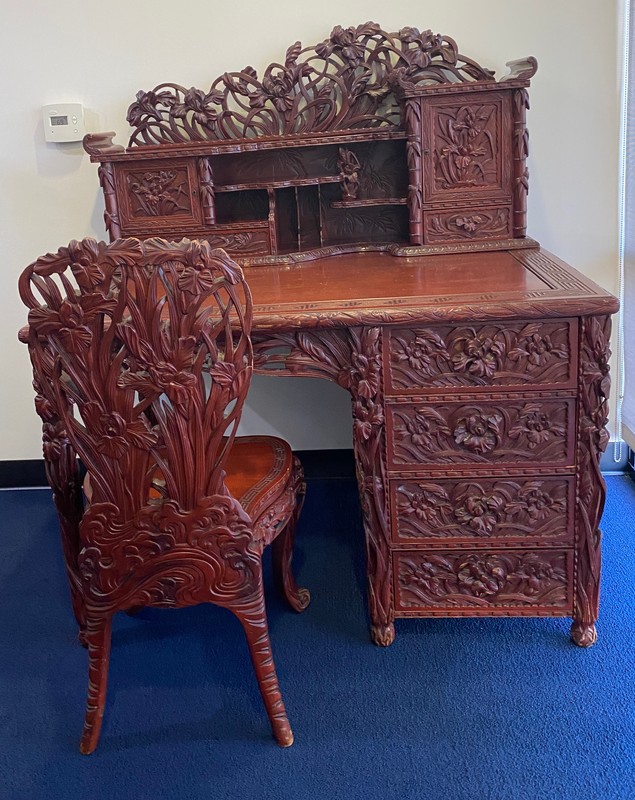
Chinese rosewood table with a marble top and inlaid mother of pearl.
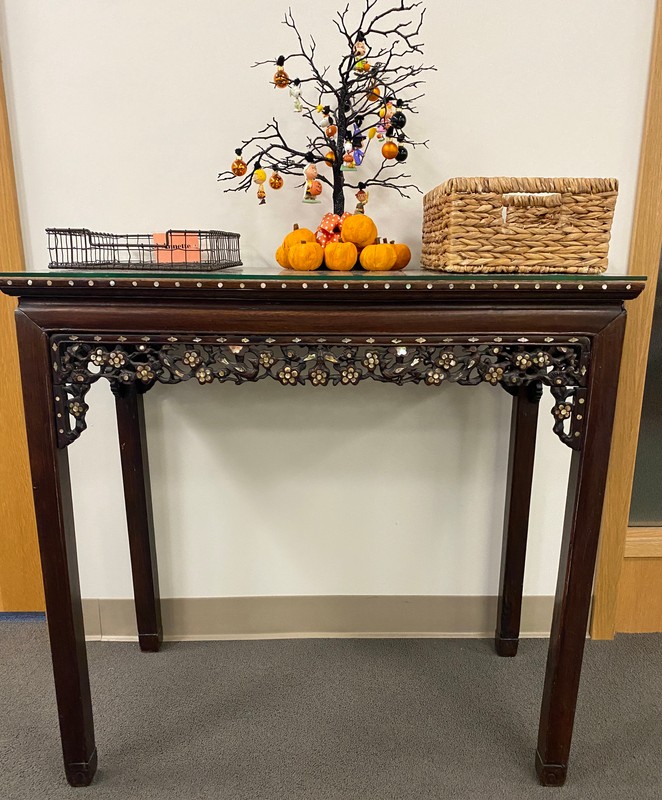
Pink marble top of the side table
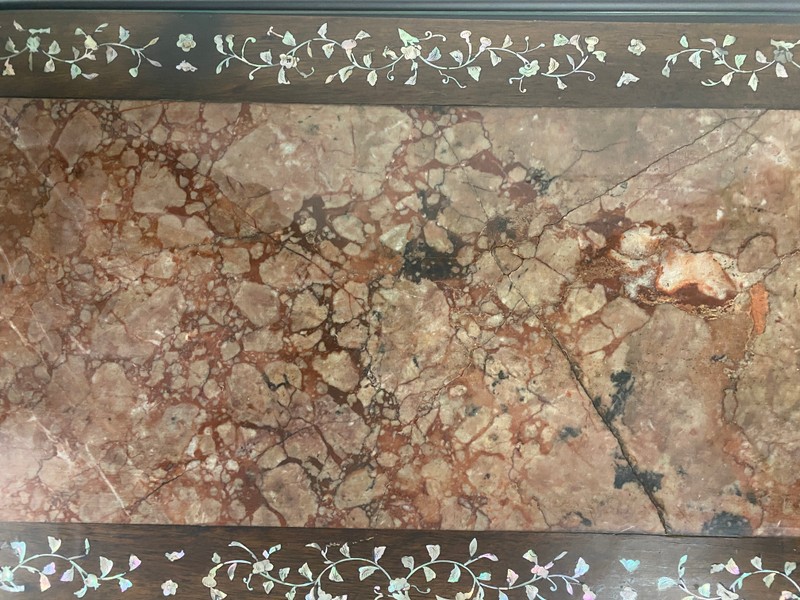
Inlaid mother of pearl around the sides of the marble table.
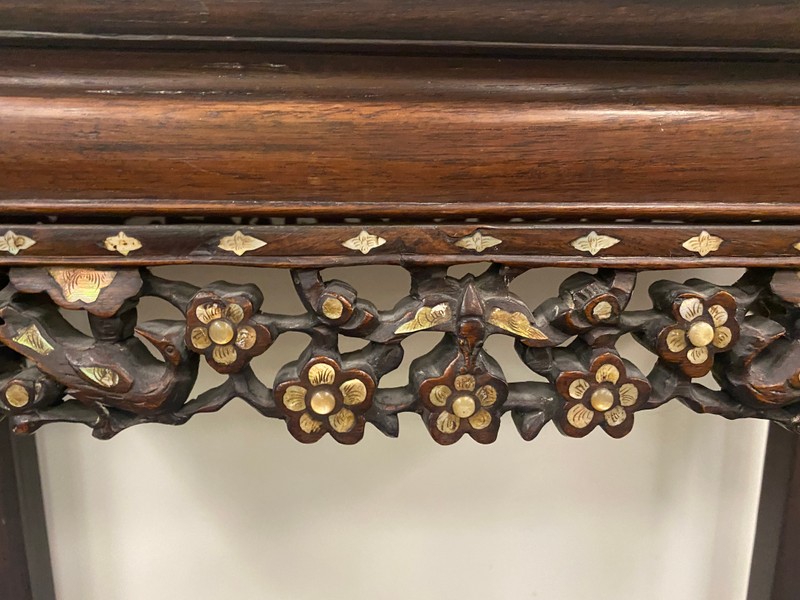
Vienna eight-day regulator clock--a gift from Las Hermanas in 1970
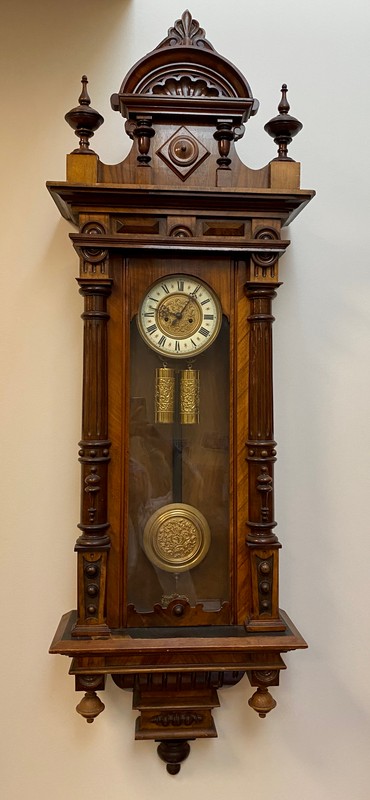
Very old Korean Tansu chest with brass furnishings just outside the president's office.
.jpg)
Backstory and Context
Text-to-speech Audio
The best way to experience this part of the tour is to have your phone open to this section as you walk around and look closely at each piece of furniture...
As you enter the Breslauer Chapter room, on the left stands a small Chinese padouk wood, two-piece jewelry cabinet. Three-clawed walking dragons are carved on the front doors, and on the sides are phoenixes among clouds. The cabriolet legs are carved with griffin designs. Carved above the lintel is a three-clawed walking dragon with a small dragonfish at each side. Behind the dragon doors, the upper part has eighteen drawers--just right for a lady-of-the-court’s jewels. Two more drawers open on the outside beneath the dragon doors...
Of special interest is the Qing Chinese blackwood banquet table and 12 chairs originally made for the German ambassador to the kingdom of Hawaii. With its three leaves, it is 11 feet long. The Howards loved to serve dinner to their friends at this magnificent dining table. The legs, corners, and edges of the table are intricately carved in a floral motif. The side chairs have two carved dragons facing each other on the back. The two armchairs have three figures in a garden carved on the back...
Next, another of the padouk pieces, the china hutch contains sets of Canton famille rose porcelain dinnerware. Notice the writhing dragons on top and the asymmetry of the shelves. On the interior, the back is carved with plum blossoms and bamboo. The off-set, serpentine top shelves have two songbirds carved at the edges. The lower section has two drawers with carved handles of front-facing ferocious monstrous heads surrounded by clouds. Like the jewelry cabinet, griffins are carved on the cabriolet legs...
Our newest addition to the decor of this room is the ink-on-paper ancestor scroll. This one is unique because it shows five generations of ancestors. Respect for elders and reverence for their ancestors is very important in Chinese culture...
In the 1860s, four German-Swiss artisans spent three years carving the seventeen-foot American mantle and fireplace and the two cabinets along the west wall for the mayor of New York City, Charles Godfrey Gunther. The craftsmen used Hungarian walnut wood, both elegant and expensive, but difficult to carve. At some later date, Alfred Dolge, a wealthy entrepreneur who manufactured piano parts, purchased the mayor’s furniture for the 12,000 square foot home he built west of Albany, New York. Mr. Dolge’s business philosophy was unusual because he believed that the workers should benefit from the profits as much as the business owner. He even created pensions for his workers. The capitalist bankers in his area were unhappy with his ideas. After a scandalous financial upheaval and forced bankruptcy, Mr. Dolge eventually moved his family, and the furniture, to California to work for Mr. Henry Huntington. After Mr. Dolge’s death in 1922, Mr. and Mrs. Howard purchased these remarkable pieces for their Long Beach home...
The mantle and fireplace depict scenes of hunting and fishing. The central carving at the top is of hunting dogs closing in on a deer. At the top of each side is a Native American on a pedestal, one hunting with a spear and the other with a string of fish. In the center of the upper portion, a large mirror is decorated on each side with an owl and trophies of the hunt below. At the top of the mirror is a sweet cherub watching over all who gather here. Just below the central mantel ledge, the heads of two dogs and a lion protrude. In the lower portion of the fireplace, a hunter with a gun stands on the left and a fisherman holds a net and fish (missing) on the right. Both are wearing plumed hats and clothing typical of the 17th century. Griffins and symbols of the hunt and harvest are shown around the edges of the arch of the fireplace. Such an elaborate piece of furniture makes a dramatic statement about its owners and the artisans who created it...
To the right of the fireplace is the Chinese high-backed padouk monkey chair carved with two monkeys (symbols of mischief and trickery) climbing a tree to get to the peaches (symbols of immortality). Notice that the arms of the chair are carved as dragon faces with ivory eyes and pearls in their mouths. This chair also has griffins on its cabriolet legs...
The 19th century Chinese Coromandel lacquered wooden screen features inlaid mother of pearl and ivory. Hawks and small birds stand on flowering branches in the four panels. The wood was carved before as many as thirty coats of lacquer were applied. The lacquer techniques were developed during the Ming dynasty (1368-1644). The name refers to the Coromandel Coast in India where screens and other furnishings from China were loaded onto ships carrying goods to Europe...
The top of the late Qing Chinese blackwood buffet has three sections carved in openwork design of dragons facing a sun. The back of the central area is intricately carved openwork in designs of pine trees, ginkgo leaves, gourd vines, bamboo, and ling chih or lingzhi (fungus)--symbols of longevity and immortality. The frame at the front of the center section includes birds and plum blossoms. Two side doors are ornately carved in a grape design and below the doors are open areas. The lower chest has five drawers and four cabinet doors carved with vines, pomegranates, fungus, peonies, and butterflies--symbols of longevity and happiness. Three horizontal carved panels are inset into elaborately carved frames to decorate each side. Eight ball and claw feet support this piece of furniture. This appears to be a custom-made piece filled with symbols of the good things of life—happiness, immortality, and numerous children...
Tall Breakfronts...
· The central carvings at the top of the two breakfronts are identical and depict two scantily clad men with a dog ready for a hunting expedition. Directly below the hunters are helmets and breastplates of armor, battleaxes, and shields. Another similarity is that the doors on the lower section of each breakfront have identical carvings of heads with long tongues extended, similar to doorknockers. Jesters’ heads are carved in the triangular sections above the arched doors. The locked drawer in the center of each piece is carved with two hunting dogs facing each other. The head of a lion serves as a drawer pull on each side of this center section. Accessed with a secret lever, the decorated areas on both sides of the bottom section open to allow access...
· To the left of the window stands the south breakfront. At the top of the left side stands a young man reading a book. The upper left pillar is carved with the tools of writing and the head of William Shakespeare. On the lower left pillar, the head of the mythological god, Pan, and his flute are carved. At the top of the right side is another figure holding a geometry compass. The upper right pillar has musical instruments and the face of Ludwig van Beethoven. The right lower pillar has tragedy’s mask, crossed swords, a mace, and skull. Is that the skull of Hamlet’s “Alas, Poor Yorick?”...
· The north breakfront to the right of the window is the same as the other breakfront in most areas but has different side carvings. At the top left side is a young man holding an object that is now missing. The upper left pillar has tools for navigation and sailing including spyglasses, logbooks, sextants, a globe, and the head of Christopher Columbus. On the lower left pillar, paint brushes, a palette, easel, and other artists’ tools are carved. At the top right side is a young man holding a chisel and hammer. The upper right pillar has tools for mechanical drawing including a compass, folding ruler, triangle, scroll, ruler, pen, and the head of Leonardo da Vinci. The lower right pillar contains calipers, centering tripod, scroll, dividers (compass), ship’s figurehead and shipwright’s mallet...
· The tall breakfronts feature likenesses of some of the most creative and daring men in history, complete with symbols of their crafts. The exquisite detail in such difficult wood attests to the talent of the original German-Swiss immigrants who traveled to America for this project. If the wood could speak, what would it say about the artisans who created these amazing sculptures? Do the cabinets wonder why the lower pillars do not match the person depicted above, but match the person on the opposite side? Was it the artisans’ plan to make viewers look closely, or were the cabinets reassembled incorrectly after the trip to California? We may never know...
Next, against the west wall are four padouk dragon chairs. Each arm is sculpted as a dragon with a pearl of wisdom in its mouth. The backs of the chairs have openwork sculpture of a three-clawed dragon, but two also have a phoenix included, most likely for women. The seats of two chairs have carved dragons and one chair is plain. However, the fourth chair has Chinese characters that translate to “wishes for good fortune, prosperity, and longevity to express well wishes for a happy and fulfilling life,” according to Le Tran, our translator...
The top of the padouk square table is carved with a central design of a dragon surrounded by a cloud and thunder design. The outside apron is carved with grape vines and grapes that meander down the cabriolet legs...
The framed skirts above the table and two chairs were worn by Qing Han Chinese women in the late 1800s. The elaborate embroidery most likely was done by bound-foot women preparing clothing for celebrations...
Other furniture...
Foyer...
The first piece of furniture that you notice when you enter the Cherise Mari Laulhere Philanthropic Center is a large, round blackwood gaming table with a plain top under glass. The wide outer rim is carved in high relief in designs of several different species of flowers. This is a custom-made piece from the 19th century Qing dynasty...
Two Chinese chairs in the northeast corner of the foyer sit beside a large Japanese bronze temple vase. Look closely on the vase at detailed birds and phoenixes in high relief...
Board Room...
Near one of the board room entrances stands a Chinese piece with three open shelves and two drawers below. Openwork sculpture of bamboo stalks and leaves decorate the sides, while carvings of berries, grapes, and leaves enhance the drawers...
Tucked in a corner of the board room, this desk and chair set was donated to the Asian Art Collection. According to the donors, the desk is carved from the trunk of a single gum tree. However, a gum tree, or eucalyptus, is very difficult to carve because it cracks easily. Finding out more about this red lacquer desk and chair will be interesting...
Main Office...
In the main workroom outside the executive director’s office, the top of a rectangular side table is adorned with mother of pearl plum blossoms surrounding an inset piece of pink marble. The apron around the table features openwork carving of birds among blossoms inlaid with mother of pearl...
Outside the president’s office is a Korean Tansu chest with brass fittings. It has a large lock and hasp and two handles on the front. This was Mrs. Howard’s only Korean furniture and was from the late Yi dynasty (late 19thcentury)...
Above the Korean chest is a Vienna eight-day regulator clock with a hand-carved English walnut case. It has a beautifully engraved matching pendulum, weights, and dial. Circa 1870-1880. The clock was presented to Assistance League of Long Beach on April 27, 1970, by Las Hermanas Auxiliary in celebration of the auxiliary’s tenth anniversary...
A special thanks to Assistance League of Long Beach chapter members Ruth Boorkman, Ann Exley, Lorraine Miller Collins, and others for the extensive research they did in the early years of the Howard and Asian Art Collection.
Cite This Entry
STW on behalf of Assistance League of Long Beach. "Furniture." Clio: Your Guide to History. January 5, 2024. Accessed April 2, 2025. https://theclio.com/entry/171777
Sources
“Art in Wood.” Out West Magazine. Edited by Chas. F. Lummis. December 1902.
Inventory: Chinese Collection and Objects of Art. Estate of Margaret H. Howard. Turned over to Assistance League by Court Order dated July 20, 1948.
Boorkman, Ruth. Exley, Ann. Illustrated Guide to the Howard and Oriental Collection of the Assistance League of Long Beach. Volume 4. Long Beach, California. Assistance League of Long Beach, 1975.
Kates, George N.. Chinese Household Furniture. New York, New York. Dover Publications, Inc., 1948.
Cooney, Michael. "The Downfall of Alfred Dolce." Upstate Earth:Beginning in the Hudson and Mohawk Valleys of New York State. February 1, 2011. Accessed October 6, 2023. https://upstateearth.blogspot.com/2011/02/downfall-of-alfred-dolge.html.
Jiang, Fercility. "Antique Chinese Furniture from the Ming and Qing Dynasties." Traveler's Choice TripAdvisor. January 15, 2023. Accessed November 14, 2023. https://www.chinahighlights.com/travelguide/culture/ancient-chinese-furniture.htm.
Cottrell, James. "Know your huanghuali from your chicken-wing? Common woods used in Chinese furniture." Shimu. December 3, 2019. Accessed November 7, 2023. https://www.shimu.co.uk/blogs/news/common-woods-used-in-chinese-furniture#
Howard Collection 85.03
Howard Collection. 85.03
Howard Collection 85.03
Howard Collection 85.03
Howard Collection 85.08
Howard Collection 85.08 A
Howard Collection 85.08 D
Howard Collection 85.08 B
Howard Collection 85.02
Howard Collection 85.02
Asian Art Collection 66.19
Asian Art Collection 66.19
Asian Art Collection 66.19
Asian Art Collection 66.19
Howard Collection 85.24
Howard Collection 85.24
Howard Collection 85.24
Howard Collection 85.24
Howard Collection 85.13
Howard Collection 85.13
Howard Collection 85.13
Howard Collection 96.01
Howard Collection 96.01
Howard Collection 96.01
Howard Collection 85.06
Howard Collection 85.23
Howard Collection 85.23
Howard Collection 85.23
Howard Collection 85.22 and 85.23
Howard Collection 85.22 and 85.23
Howard Collection 85.22
Howard Collection 85.22
Howard Collection 85.22
Howard Collection 85.14
Howard Collection 85.14
Howard Collection 85.15
Howard Collection 85.07
Howard Collection 85.25
Asian Art Collection 85.25
Howard Collection 41.31
Howard Collection 41.31
Howard Collection 41.31
Howard 85.01
Asian Art Collection 85.26
Howard 85.05
Howard Collection 85.05
Howard Collection 85.05
Chapter Inventory
Howard Collection 85.09

